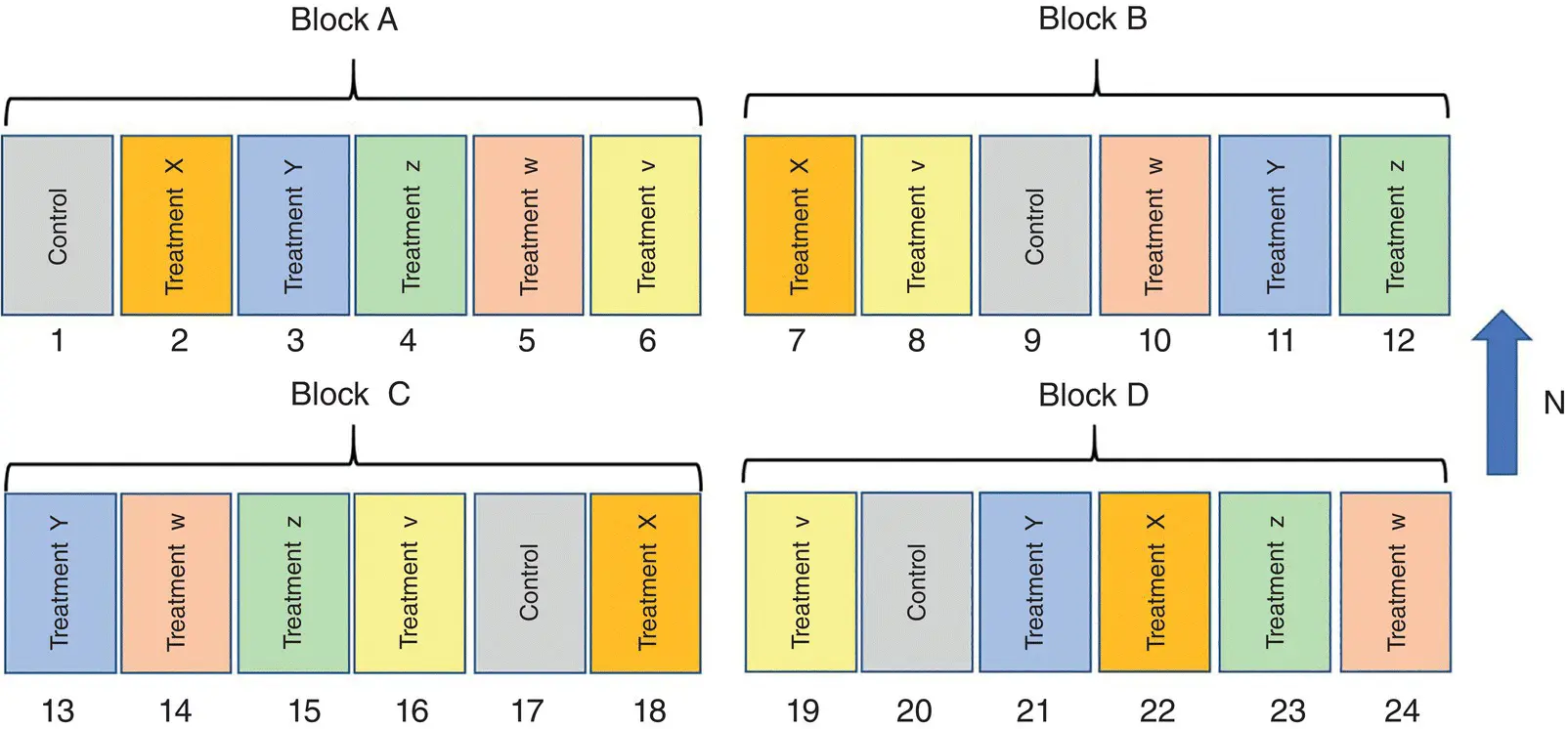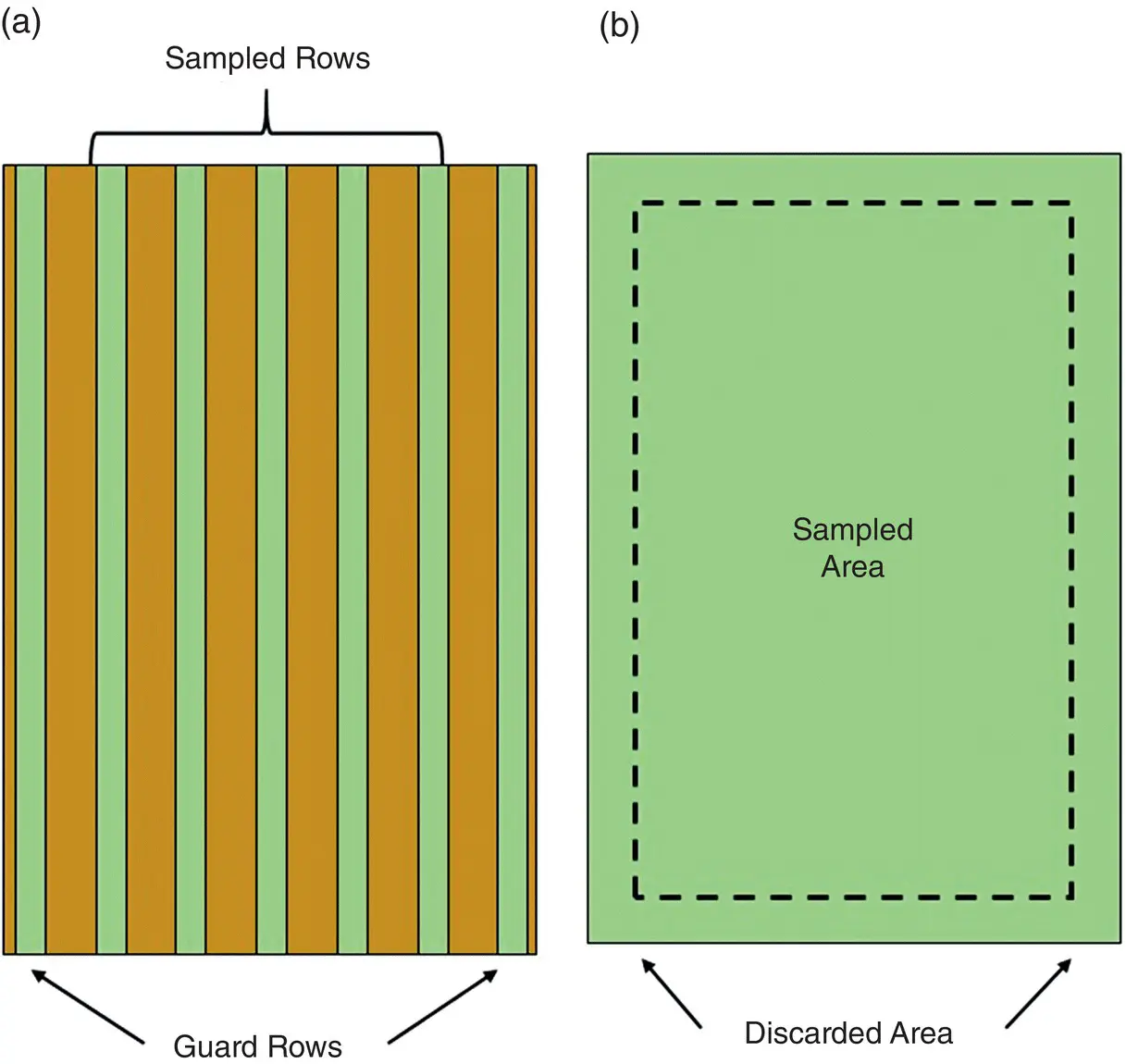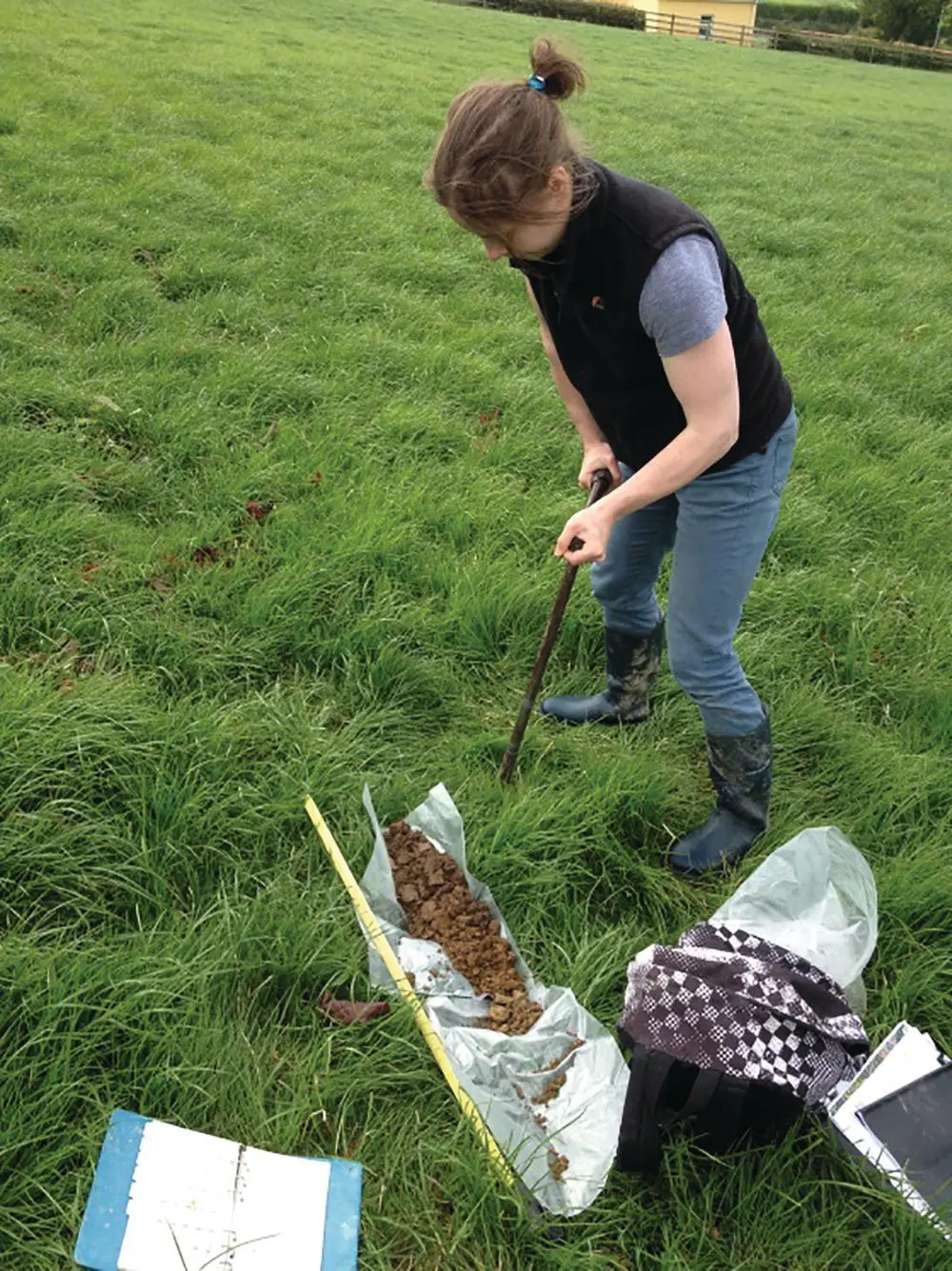
Fig. 2.1 Plot and row experiments at a crops research station.
Source: Colum Kennedy, Teagasc.

Fig. 2.2 Signs like these can be helpful in identifying which plots receive certain treatments.
Source: Jaclyn Fiola.

Fig. 2.3 Care should be taken when harvesting field trials to accurately record yields without damaging the plot. Make sure that your mower has appropriate tyre pressure and that the blades are set to the correct height.
Source: Sara Vero.

Fig. 2.4 Example of a field plot layout including four blocks, each with five treatments and one control. Treatments within each block are randomized.
Source: Sara Vero.
The size of plots can vary immensely, from a couple of square meters to “strip” plots, encompassing entire crop rows or even fields or parcels measuring several hectares. Smaller plots allow more treatments to be applied but may suffer from greater edge effects and the measurements within each plot will be more subject to site‐specific variables. Larger plots or strips may smooth out these influences but are logistically demanding. Field research is often limited by available area (particularly if you are being hosted by a participating farmer rather than a research farm owned by your institution or university), and large‐scale trials are more expensive to establish and maintain. Irrespective of the size of your plots it is important to impose adequate spacing or barriers between them so that the treatments applied to each plot do not affect those adjacent to it. For example, if you are examining the efficacy of an herbicide on mixed species swards, airborne drift of the chemical could lead inadvertently contaminate other plots. Be sure to account for spacing in your initial design and layout of your plots.
Another consideration in determining plot size is the nature of the treatment. Some treatments are well suited to plots measuring just a few square meters, for example, seed mixes or herbicide treatments. Others can only be implemented at a row or field scale to be representative of farm practice, because of the size of machinery involved or due to the size of plant species being examined. Treatments requiring this larger scale approach might include cultivation practices, investigation of subsurface drainage systems, or testing of irrigation systems (among many others).
Plot experiments are well suited to randomization (e.g., complete or incomplete randomized block design, split plot arrangements, multifactorial design, etc.). Some excellent and detailed aids to selecting the appropriate treatment design are provided by Oehlert (2010), Cassler (2014), and Glaz and Yeater (2017).
A consideration when running plot trials (or row trials for grain crops) are edge effects. Edge effects manifest as differences in growth pattern near the perimeter of plot or row trails, compared with at the center. There are two types of edge effect: border effect and neighbor effect (Langton, 1990). Border effect occurs because plants growing along the perimeter experience slightly different conditions than those in the center. For example, they may be more exposed to wind or inclement weather. Neighbor effect occurs when a plot is influenced by neighboring treatments, plots, or untreated ground outside the plot margin. Examples of this include drift of herbicide treatment or interaction of plant roots below the surface. Edge effects are more pronounced in small plots, so a common preventative measure is simply to use larger plots. You should consider whether this is possible with respect to the additional workload and the area available for your trial. Guard rows (grain crops, shrubs, trees, and vegetables) or edge trimming (grasses) can also be used to avoid edge effects. In using guard rows, one or more additional rows of crop are planted at the edge of each plot or row ( Fig. 2.5a). These are discarded before sampling the main plot itself. Similarly, edge trimming means that a predetermined area of the plot is cut and discarded, while only measurements taken from the center of the plot are used for analysis ( Fig. 2.5b) (Peterson, 1994). Alleys (gaps between plots) or temporary screens can be used to avoid treatment drift between neighboring plots. Guard rows and edge trimming are not used in all plot trials; you should consider the literature in your subject area and the specific details of your planned experiment when deciding if and how to implement these measures.

Fig. 2.5(a) Guard rows in row crop trials. (b) Discard area and sampled area in a plot trial.
In field surveys, the researcher collects data from across an area with a view to defining spatial characteristics or patterns ( Figs. 2.6and 2.7). Surveys may be repeated to determine trends over time. Depending on the size and nature of the study area, surveying can be time‐hungry and physically challenging. Frequently (although not always), survey data can be expressed using maps, which is engaging for the audience or reader if done well.

Fig. 2.6Researchers embarking on a survey in the mountains.
Source: Jaclyn Fiola.

Fig. 2.7 Soil surveys are just one form of field work used to develop and validate soil maps.
Source: Sara Vero.
Survey types in environmental science include:
Soil mapping
River chemistry snapshots
Groundwater well dipping (for determining watertable depth)
Species characterization (plant or animal)
Topographic mapping
Geological survey
Although it is not strictly a biophysical method, surveys of farm management such as fertilizer rates, timing of cultivation, and stocking rates have an important role in agricultural and environmental research. These factors may influence your observations and are crucial to interpretation of results. Recording farm practices requires the involvement of the farmer or farmers on whose land the research is conducted or who live within a study catchment or watershed. For catchment‐scale studies (in agricultural landscapes), it is desirable to have a representative proportion of farmers participating in record‐keeping. These records can be demanding, both for the researcher and the participants so it is helpful to be clear at the initiation of the study what each party is expected to record and how they are to do it. Hard‐copy or online diaries help the farmer to keep track of their activities, particularly those details which you are interested in.
Читать дальше



















